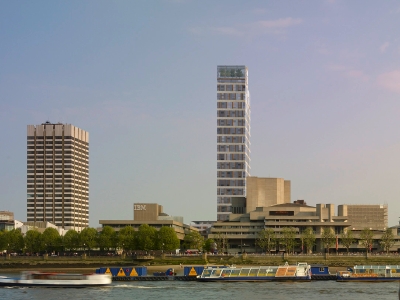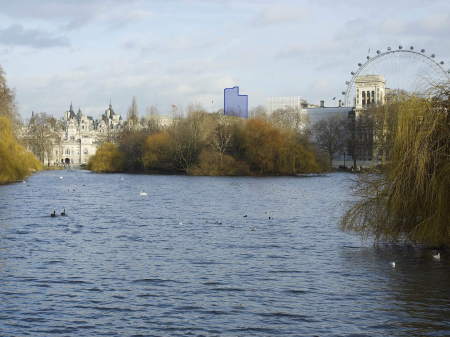Doon Street Tower "vital for this part of London"?
The public inquiry into the proposals for a 44-storey tower and leisure centre on the South Bank is about to enter its third and final week.


The inquiry, which opened at Lambeth Town Hall on 12 February, did not sit last week but will resume on Tuesday 4 March for its final four days.
Local social enterprise Coin Street Community Builders (CSCB) wants to build a 44-storey tower on a vacant site it owns between Upper Ground and Doon Street, close to the National Theatre.
The scheme would include an 8-lane 25-metre public swimming pool and learner pool, a 120-piece gymnasium, two aerobics studios and a 4-court multi-purpose sports hall.
These ambitious facilities would be part-funded by the sale of 329 private homes in the building above and adjacent to the leisure centre.
The scheme – approved by Lambeth Council last August – attracted opposition because of the tower's impact on the protected view from the bridge in St James' Park and its visibility from the upper terrace of Somerset House, as well as the absence of any affordable housing within the proposals.
Last autumn communities secretary Hazel Blears, acting on the advice of English Heritage, ordered a public inquiry into the proposals which is currently under way.
Westminster City Council
On Wednesday 20 February the inquiry heard from Robert Ayton of the City of Westminster's planning department.
His evidence highlighted the divergence in opinion between Westminster and the Greater London Authority about the protection of important views in central London.
"They [the GLA] are in danger of destroying some of the heritage assets of London. They don't worry about that, but we do."
Mr Ayton told the inquiry that "Westminster is not opposed to tall buildings, just to tall buildings that harm heritage assets."
He called for a study of building heights in the Waterloo area to establish what could be built on the South Bank without damaging views from the City of Westminster.
"You'll still have tall buildings but they won't be super-tall," he said.
He said that such a study would bring greater certainty for both developers and council planners: "I think it would be much better if we all knew what heights were permissible."
He added: "I think the Doon Street Tower is a fine building in its own right but it's in the wrong place" because of its impact on key views.
English Heritage
The inquiry also heard from Paddy Pugh of English Heritage who outlined his employers' key objections to the scheme which centre on St James' Park and Somerset House.
"English Heritage does not accept that the applicants have demonstrated that a large-scale development can only be successfully designed as a single tower," he said.
"It has been suggested at the inquiry that tall buildings help to demonstrate that regeneration is happening and that the Doon Street Tower would therefore be a positive beacon for regeneration in the area.
"However, tall buildings are far from the only possible indicator of regeneration."
He drew a comparison with the acclaimed redevelopment of the railway lands at King's Cross where most of the new buildings are of 10 storeys or less.
"English Heritage believes, as does CABE, that as a matter of principle there should be no visual intrusion into the setting of the courtyard of Somerset House when viewed from the north."
Pugh rejected the "qualitative subdivision of the courtyard" of Somerset House whereby CSCB have sought to demonstrate that the upper terrace and the fountain court are separate entities.
"The entire composition is of extremely high architectural and historical interest," he told the inquiry.
"The ability to appreciate such a fine building with a clear sky above is unrivalled in Central London."
He added: "This is undoubtedly an exceptional case that calls for the most rigourous application of planning law, national policy and guidance."
Pugh was questioned by William Hicks QC (for Coin Street Community Builders) on the partisan campaigning tone of the material placed on English Heritage's website ("A towering mistake for London's skyline") in connection with the inquiry.
"It's factually correct," he replied. "It might not have the gloss on it you would like."
Valerie Shawcross AM
On Friday 22 February the inquiry heard from local London Assembly member Val Shawcross gave a glowing endorsement of the "very fine proposal" for Doon Street.
"I am keenly in support of the proposed scheme which I see as the bringing much needed public swimming and leisure facilities to an area which is otherwise dominated by 'national' arts institutions, businesses and housing. Such local public facilities will anchor and support the retention of a "family" orientated community and a better mix of local facilities.
She added: "I have a concern that the boroughs I represent are in danger of suffering a suppression of their development potential because of subjective and over-sensitive 'aesthetic' concerns expressed by English Heritage and wealthier boroughs north of the river Thames."
Kate Hoey MP
Vauxhall MP Kate Hoey also expressed her strong support for the proposals. She also rejected the concerns of English Heritage and CABE about the visibility of the tower from the upper terrace of Somerset House.
"This is an area used by service vehicles, has a hodge-podge of signs and barriers, is not a place where people tarry or where seating is provided, does not form part of the courtyard where people assemble, and is not a space which requires any special protection.
"Although I have regularly opposed tall buildings which have not been suitably located or designed, I have no hesitation in giving my full support to the Doon Street proposals which have been very carefully considered, have been revised in the light of consultation, and will bring genuine benefit to local people.
"Like the London Eye – which I also strongly supported – the Doon Street scheme is vital for the future of this part of London. It directly addresses community needs, it creates employment and training opportunities, it offers substantial health and education benefits, and it has been designed by leading architects who have already played an important role in the regeneration of the area..."
Southbank Centre
Southbank Centre chief executive Michael Lynch also gave evidence to the inquiry as a third-party supporter of the proposed scheme. He outlined the strategic benefits of the Doon Street development in terms of the Rambert Dance Company's contribution to the cultural quarter, the new public space to be created next to Waterloo Bridge and the much-needed community leisure facility.
Jenny Mosley
Jenny Mosley – a resident of the Iroko Housing Co-op built by Coin Street Community Builders – told the inquiry that "Waterloo has been crying out for this development for a long time".
"The average person doesn't give a hoot about views from listed buildings and parks," she said.
Cllr Paul McGlone
Cllr Paul McGlone, Lambeth's cabinet member for regeneration, described the proposal as "an iconic, elegant tall building" that will "act as a catalyst for other inward investment in Lambeth".
He noted that the scheme is the second highest-value planning application the borough has dealt with in recent years.
South Bank Employers' Group
The inquiry also heard from Ted Inman, chief executive of the South Bank Employers' Group (of which CSCB is a member). He outlined the organisation's support for the scheme and warned of an "over-emphasis on heritage aspects".
SE1 United
Jacob Whittingham, activities manager at SE1 United, the Waterloo-based forum for local young people, spoke powerfully about local social issues including obesity, youth-on-youth crime, unemployment and educational under-achievement.
"We have a social responsibility to approve this," he told the planning inspector.
City of Westminster's closing submission
Although the inquiry will sit for another four days, the City of Westminster has already made its closing submission.
"We reject an approach that says world class architecture can overcome any scale of harm," said Peter Harrison QC.
He went on to accuse CSCB of treating the inquiry as "a call to arms for modern architecture", and criticised the approach of branding opponents of the scheme as "historicist" for "generating more heat than light".
Mr Harrison said that the applicants were "simply unable to recognise any possibility of harm".
"The proposals will cause harm and will have benefits. We are clear how that balance should be resolved and that is to refuse planning permission."
In addition to the scheme's impact on the views from St James' Park and Somerset House, Mr Harrison warned that the tower would "dominate and overpower the National Theatre".
He argued that a tower of a similar height to the Shell Centre or LWT "would sit more comfortably in the overall view".
Leading architects come out in favour of tower
Outside the inquiry the proposals have won the backing of a number of leading names in British architecture.
"This is a handsome proposal full of benefits for the South Bank with a tower of elegant proportions that appears in some distant views where it will have no discernable effect other than adding to the vitality and quality of London's skyline," says Lord Rogers, who designed an unbuilt commercial scheme for the Coin Street estate nearly three decades ago.
The proposals have also been endorsed by London Eye creators Julia Marks and David Barfield, as well as Sir Terry Farrell, Marco Goldschmied and Rafael Vinoly.
• This week the inquiry will hear from third-party objectors to the proposals, including the Waterloo Community Development Group and individual local residents. Full coverage on this website.
Comments
Share
The SE1 website is supported by people like you
More to read
- Channel 4 to make reality TV show in South Bank Tower penthouse 9 Nov 2022
- Lambeth paves the way for skyscraper on Waterloo IMAX site 8 Oct 2018
- Artist and activist Veronica Planton remembered at Waterloo exhibition 6 Jul 2014
- Queen opens Rambert dance company HQ on the South Bank 21 Mar 2014
- SE1 joins 'prime' central London property market 15 Oct 2013
- South Bank Tower: council approves 5 extra floors and collects £5m 17 Jul 2013
- Shell Centre redevelopment approved: nearly 900 South Bank homes 22 May 2013
- Rambert's dancers get preview of new South Bank headquarters 21 May 2013
- Lambeth kids visit Rambert Dance Company's new South Bank home 6 Mar 2013
- MBE for Coin Street boss Iain Tuckett in New Year honours list 29 Dec 2012
Related forum discussions
- "Mama Mia: The Party" coming to Coin Street?
- Elephant and Castle Leisure Centre Project Consultation
- Blackfriars Road skyscrapers
- Mayoral Election.
- Coin Street's revised plans for a tower of only 43 storeys - still a betrayal of their founding principles?
- New development on Recall site
- London Park Hotel Site
- Swimming lessons for young children
Follow us
Email newsletter
For the latest local news and events direct to your inbox every Monday, you need our weekly email newsletter SE1 Direct.

